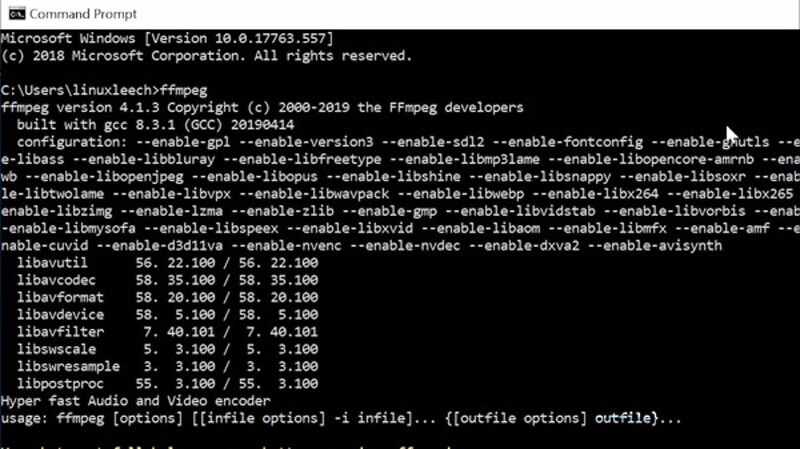

- Download ffmpeg for cmd how to#
- Download ffmpeg for cmd mp4#
- Download ffmpeg for cmd install#
- Download ffmpeg for cmd portable#
Download ffmpeg for cmd install#
# yum install glibc gcc gcc-c++ autoconf automake libtool git make nasm pkgconfig SDL-devel \Ī52dec a52dec-devel alsa-lib-devel faac faac-devel faad2 faad2-devel freetype-devel giflib gsm gsm-devel \

Libxext-dev libxfixes-dev pkg-config texi2html zlib1g-dev Libsdl1.2-dev libtheora-dev libtool libva-dev libvdpau-dev libvorbis-dev libx11-dev \ $ sudo apt-get -y install autoconf automake build-essential libass-dev libfreetype6-dev libgpac-dev \ Install the dependencies with the following command. The installation of these dependencies can be done with the help of the following commands.įirst, tell the system to pull down the latest packages. First, make sure your system meets all the dependencies. $ sudo zypper addrepo -cfp 90 '$releasever/' packmanĬompiling software from a source is not the easiest thing in the world, but with the right instructions, we will be able to do it. $ sudo zypper install -from packman ffmpeg Install FFmpeg on openSUSE - On openSUSE Tumbleweed. Install FFmpeg on Arch Linux $ sudo pacman -S ffmpeg $ sudo dnf install $(rpm -E %fedora).noarch.rpm $(rpm -E %fedora).noarch.rpm On Fedora, you need to install and enable RPM Fusion to install FFmpeg as shown. On CentOS & RHEL 6.x -Īfter enabling repositories, run the following command to install FFmpeg: # yum install ffmpeg ffmpeg-devel To install and enable RPM Fusion, use the following command on your distribution version. To install and enable EPEL, use the following command. To install FFmpeg on CentOS and RHEL distributions, you need to enable EPEL and RPM Fusion repository on the system using the following commands. The FFmpeg package is included in the official Debian repositories and can be installed using the package manager as shown. Open a new terminal ( CTRL+ALT+T) and then run the following commands. I will install FFmpeg from the default repositories. Let’s start with the installation of the FFmpeg framework in Ubuntu-based distributions. Since the FFmpeg packages are offered for the most used Linux distributions and the installation will be relatively easy.
Download ffmpeg for cmd how to#
How to Install FFmpeg Multimedia Framework in Linux

In the next part, we will practice with some of the FFmpeg multimedia framework tools, but before doing that we have to install them in our Linux box. The above command is only useful for explanation, it is not recommended to be used in practice because the codec, bitrate, and other specifics are not declared. # ffmpeg -i Lone_Ranger.mp4 Lone_Ranger.avi
Download ffmpeg for cmd mp4#
The following command will convert your mp4 file into an avi file, simple as that. Let me take an example, a very simple one. There are many other practical things that you can do with the help of the FFmpeg framework such as converting your wav file to an mp3 one, encode and decode your videos, or even scale them.Īccording to the official website, FFmpeg is able to do the following. I am very sure you will find this framework very useful when you would like to do some digital audio and video streaming or recording. The FFmpeg framework offers high security and the reason for this is the seriosity of the developers when they review the code, it is always done with security in mind. According to the description of FFmpeg on the official website, the reason for having such a great multimedia framework is the combination of the best free software options available.

This framework is really powerful due to the diversity of available tools, that provide the best technical solution for the user.
Download ffmpeg for cmd portable#
For example, the ffplay is a portable media player that can be used to play audio/video files, ffmpeg can convert between different file formats, ffserver can be used to stream live broadcasts and ffprobe is able to analyze multimedia stream. FFmpeg is one of the best multimedia frameworks that contains various tools for different tasks.


 0 kommentar(er)
0 kommentar(er)
